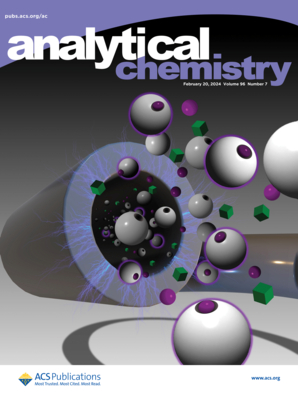Precision Visualization of Surgical Margins and Depth Imaging Performance in Orthotopic Hepatocellular Carcinoma Using Galactose-Targeted NIR-II Fluorescence Nanoprobe.
IF 6.7
1区 化学
Q1 CHEMISTRY, ANALYTICAL
引用次数: 0
Abstract
Accurate identification of tumor margins during liver cancer resection is crucial for improving prognosis and reducing postoperative complications. This study investigated the feasibility of using a galactose-targeted nanofluorescent probe known as Gal-OH-BDP NPs (GOB NPs), which emits in the NIR-II window, for fluorescence imaging of orthotopic hepatocellular carcinoma in animal models. In vitro imaging was performed with Intralipid emulsion and chicken breast to assess the tissue penetration depth of the GOB NPs and ICG in the NIR window. In vivo NIR-I/II imaging was conducted in orthotopic liver tumor animal models. Pathological validation confirmed that intratumoral injection of GOB NPs resulted in targeted accumulation within liver cancer tissue. Quantitative image analysis revealed that GOB NPs-mediated NIR-II imaging exhibited the highest fluorescence intensity at the tumor site and the lowest background fluorescence in the liver, thus resulting in the highest tumor-to-normal liver tissue ratio (TNR) and the highest tumor margin resolution. Additionally, GOB NPs-mediated NIR-II imaging maintained effective tumor margin visibility at a depth of 8 mm, whereas ICG-mediated NIR-I/II imaging demonstrated effective detection depths limited to 2 and 5 mm, respectively. Following intravenous injection, the GOB NPs exhibited negative staining, thus clearly delineating the tumor boundaries and achieving a high contrast between the tumor and liver tissues.半乳糖靶向NIR-II荧光纳米探针在原位肝细胞癌手术边缘的精确可视化和深度成像性能
肝癌切除术中肿瘤边缘的准确识别对改善预后和减少术后并发症至关重要。本研究探讨了在NIR-II窗口中发射的半乳糖靶向纳米荧光探针Gal-OH-BDP NPs (GOB NPs)用于动物模型原位肝细胞癌荧光成像的可行性。用脂内乳剂和鸡胸肉进行体外成像,评估GOB NPs和ICG在近红外窗口的组织穿透深度。在原位肝肿瘤动物模型中进行体内NIR-I/II成像。病理证实肿瘤内注射GOB NPs导致肝癌组织内靶向积累。定量图像分析显示,GOB nps介导的NIR-II成像在肿瘤部位表现出最高的荧光强度,而在肝脏中表现出最低的背景荧光,从而导致最高的肿瘤与正常肝组织比(TNR)和最高的肿瘤边缘分辨率。此外,GOB nps介导的NIR-II成像维持了8 mm深度的有效肿瘤边缘可见性,而icg介导的NIR-I/II成像分别显示有效检测深度限制在2和5 mm。静脉注射后,GOB NPs呈阴性染色,从而清晰地划定了肿瘤边界,实现了肿瘤与肝脏组织的高度对比。
本文章由计算机程序翻译,如有差异,请以英文原文为准。
求助全文
约1分钟内获得全文
求助全文
来源期刊

Analytical Chemistry
化学-分析化学
CiteScore
12.10
自引率
12.20%
发文量
1949
审稿时长
1.4 months
期刊介绍:
Analytical Chemistry, a peer-reviewed research journal, focuses on disseminating new and original knowledge across all branches of analytical chemistry. Fundamental articles may explore general principles of chemical measurement science and need not directly address existing or potential analytical methodology. They can be entirely theoretical or report experimental results. Contributions may cover various phases of analytical operations, including sampling, bioanalysis, electrochemistry, mass spectrometry, microscale and nanoscale systems, environmental analysis, separations, spectroscopy, chemical reactions and selectivity, instrumentation, imaging, surface analysis, and data processing. Papers discussing known analytical methods should present a significant, original application of the method, a notable improvement, or results on an important analyte.
 求助内容:
求助内容: 应助结果提醒方式:
应助结果提醒方式:


